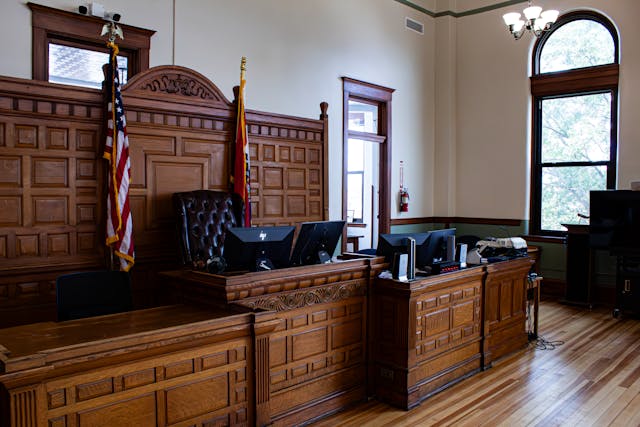The Menendez murder photos sparked intense legal and ethical debates, here’s a deep dive into the media and courtroom battles.
In the saturated landscape of true crime, few cases have gripped public fascination like that of Lyle and Erik Menendez. But beyond the brutal killings, the media frenzy, and the courtroom drama, one particular element ignited a firestorm of debate: the use and dissemination of the Menendez murder photos.
Why do certain crime scene images cross ethical boundaries? Who gets to decide whether the public has a right to see them? How do courts weigh evidentiary value against potential harm or sensationalism?
This article critically explores the complex legal and media controversy surrounding the Menendez murder photos, an issue that continues to resurface with every new wave of documentaries, re-enactments, and true crime fan forums.
What You'll Discover:
The Crime That Shattered the Beverly Hills Illusion
The Menendez brothers, Lyle and Erik, became household names in 1989 after brutally murdering their wealthy parents, José and Kitty Menendez, in their Beverly Hills mansion. The case stood out not just for its horror but for its defendants: two young, privileged sons who turned the American Dream into a gothic nightmare.
The initial investigation led nowhere, until the brothers confessed during a taped session with their therapist, which was later admitted into evidence. What followed was one of the most high-profile trials of the 1990s, and with it, came something far more controversial than just courtroom theatrics: the crime scene photos.
A Graphic Exhibit: The Legal Justification for the Photos
Crime scene photos are standard in any homicide prosecution. Prosecutors use them to support witness testimony, establish the brutality of the act, and influence jurors’ emotional responses. Legally speaking, the inclusion of such photos hinges on two major standards:
- Probative Value: Does the photo help prove a material fact?
- Prejudicial Impact: Does the emotional shock of the photo unfairly bias the jury?
In the Menendez trials, both criteria were front and center. The prosecution argued that the photos showed premeditation, head and chest shots consistent with execution-style killings, while the defense claimed the killings were spontaneous acts of self-defense, the culmination of years of alleged parental abuse.
The court admitted the photos. The legal rationale was clear: they were not just inflammatory; they were evidentiary.
Yet here’s the crux, what’s legally admissible isn’t always ethically acceptable, especially when such images become part of the broader public spectacle.
When the Courtroom Becomes a Stage
The Menendez trial was among the first televised courtroom dramas of the modern era, turning the brothers into reluctant celebrities and the trial into must-watch television. Networks seized on every detail, including the graphic photos.
TV stations blurred them. News magazines pixelated them. But the message was unmistakable: gruesome sells.
The line between journalism and voyeurism began to blur. Public consumption of these photos, even in partial or sanitized form, became a talking point far beyond legal circles. What role should media play in amplifying, or restraining, this kind of content?
Media Ethics: Information or Exploitation?
The dissemination of the Menendez murder photos forces a difficult question: Are we informing the public or exploiting a tragedy?
Many in the journalism world argue that visuals create transparency. They compel accountability. They help the public see the gravity of the crime.
But critics counter: at what cost?
Displaying the image of a blood-soaked couch, or José Menendez’s mutilated face, is more than journalistic, it’s performative. It commodifies grief. It reduces the victims to symbols in a never-ending cycle of infotainment.
And here’s the deeper dilemma, true crime consumers are often unaware of how these visuals can retraumatize surviving family members or skew public memory of the victims.
The Public Fascination: A Social Mirror
Why are people so drawn to these images?
Is it morbid curiosity? Desensitization? A thirst for justice?
The Menendez murder photos have become iconic not because they offer new insights but because they provoke emotional reactions. They are emblems of something darker, our society’s conflicted relationship with violence, justice, and spectacle.
Compare this to the O.J. Simpson trial, where graphic photos of Nicole Brown Simpson and Ron Goldman played a similar role. In both cases, jurors were forced to confront the brutality. But while O.J.’s case never fully aired such images to the public, the Menendez case eventually did, through re-airings, documentaries, and social media leaks.
Consent, Privacy, and Posthumous Rights
Here’s where it gets thornier.
José and Kitty Menendez did not consent to these images being published. Obviously, they couldn’t. So, who speaks for the dead?
Legally, the rights to images taken by law enforcement at crime scenes usually belong to the state. But ethically, that’s a minefield. Family members have little recourse if those images are later released, archived, or leaked.
In the digital age, such images are rarely buried. Reddit threads, YouTube video essays, and TikTok conspiracy theories keep resurfacing them.
Should there be stricter controls? Or does that infringe on press freedom?
Legal Loopholes and Freedom of Information
Another twist in the Menendez photo saga comes from freedom of information laws. Many jurisdictions treat crime scene images as public records. That means journalists, researchers, or even curious individuals can request access to them.
The only way to block this? Legislative action or court orders.
After the Menendez trial, several lawmakers attempted to tighten restrictions on releasing autopsy and crime scene photos. Similar efforts followed the deaths of Dale Earnhardt and Kobe Bryant, where families pushed for privacy protections after graphic images were leaked or threatened with release.
But the tension remains. Courts must balance public interest against private dignity, and there’s no consistent legal standard.
The TikTok Generation and the Repackaging of Tragedy
Let’s be honest: we’ve entered a new era of true crime content.
The Menendez brothers are having a pop culture “moment” again, thanks to a wave of TikTok videos re-examining the trial, many portraying the brothers as victims of abuse rather than cold-blooded killers. While this shift in perception might encourage more nuanced conversations about trauma and justice, it also reopens old wounds, particularly when murder photos are used as background visuals or “proof.”
It’s jarring. On one screen, a teenager lip-syncs courtroom dialogue. On another, Kitty Menendez lies dead in a blurred photograph.
This isn’t just poor taste, it’s ethical erosion. We’re repackaging grief for clout.
Comparative Case Study: The Emmett Till Photo Legacy
Not all graphic images serve the same purpose, or draw the same ethical conclusions.
Take the open-casket photo of Emmett Till, published in Jet magazine in 1955. It was a calculated decision by his mother, Mamie Till, to “show the world what they did to my boy.” It shocked a nation into civil rights action.
That image had a moral and political mission.
Compare that with the Menendez photos. No family member advocated for their release. No societal awakening followed. Instead, they became part of an entertainment narrative.
This contrast matters. It reminds us that context and intent define ethical use.
The Court of Public Opinion: Forever in Session
Whether or not you believe the Menendez brothers acted out of fear or greed, one thing is undeniable: the murder photos altered the trajectory of the trial and the legacy of the case.
They swayed emotions in the courtroom and shaped public discourse outside it.
But they also spotlighted our collective complicity. We, the audience, are not passive. We are active participants in the consumption, dissemination, and judgment of these visual artifacts.
And with every click, share, and retweet, we help determine the line between justice served and privacy shattered.
Key Takings
- Crime scene photos are legal tools, but their evidentiary value must always be weighed against potential jury bias and emotional exploitation.
- The Menendez murder photos became symbols, not just evidence, amplified by televised trials and modern media platforms.
- Ethical concerns arise when private grief becomes public entertainment, particularly without consent from families of victims.
- Comparative cases like Emmett Till’s photo reveal how context and purpose are crucial in determining whether graphic images serve justice or spectacle.
- Media consumers play a role, influencing demand and distribution through their engagement with content, especially in the age of viral crime culture.
- Legal reform is lagging, often failing to protect the dignity of victims and their families from invasive publication practices.
- Responsible true crime content requires critical thinking, empathy, and restraint, qualities often missing in today’s content-hungry landscape.





